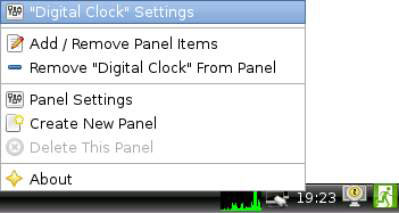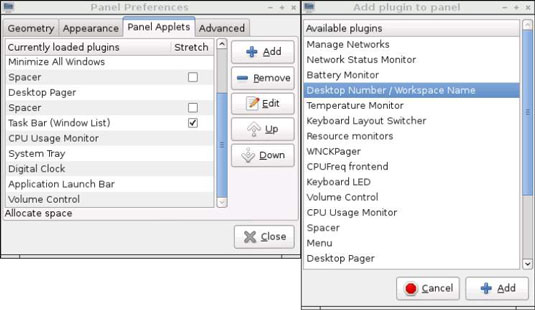When the BeagleBone Black is set up as a desktop, at the bottom of the screen is a bar known as a panel. Most people, however, would call this the task bar. This bar provides both information and shortcuts for accessing your programs.

From left to right, the task bar displays the following things by default:
Applications menu icon: The Applications menu is more or less the same as the Windows Start menu. After you’ve installed more programs, other categories should appear, such as Graphics for image-related programs and Programming for tools used to write code. Whenever you mouse over one of these categories, you see a list of applications associated with the category, and you can click a program’s name to run it.
Shortcut icons for programs: By default, the two shortcuts are for the File Manager and the web browser, but you can add other shortcuts.
Minimize-all button: This button minimizes all the windows that are open on your LXDE session.
Buttons to change into different desktops: By default, there are two of them.
All programs that you have currently running: Programs that are currently minimized have their names enclosed in brackets.
CPU Usage Monitor: The green graph displays the toll that your CPU is taking at the moment. If the CPU is currently hard at work, the rectangle is filled with green. If you just started a processor-heavy program, several peaks show up at the rightmost side. Note that this graph runs from right to left, displaying the newest data on the right.
Information about network connection: Mousing over this icon provides information regarding your network connection. You can double-click it to manage your available connections.
Digital clock: The clock displays the current time. When you mouse over the time, the date and day of the week are displayed.
ScreenLock button: At the time this book was written, that button was buggy and wouldn’t work. When the bugs are fixed, clicking the icon locks the screen so that the screen saver displays and you have to type a password when you want to return to work.
Logout button: When you click it, a new window opens so you can shut down, reboot, or log out of the current session.
Changing icon settings
Save for the CPU Usage Monitor, you can right-click all icons on the task bar to alter their settings.

Adding and removing plug-ins
You also see an option to add and remove panel items. When you choose this option, the Panel Preferences dialog box opens. Click the Add button in the Panel Preferences dialog box to see another window that features several plug-ins that you can add to the task bar. To add a plug-in, click the name of the plug-in and then click Add.

To remove a plug-in from the task bar, right-click it. Click Remove “plug-in name” (where plug-in name is the actual name of the plug-in) from Panel to remove the plug-in.
Adding application shortcuts
To add an application shortcut, you use the Application Launch Bar plug-in that’s on the task bar by default; it’s next to the Applications menu icon. Follow these steps to add a shortcut icon to the task bar:
- Right-click the Application Launch Bar plug-in icon, and choose Settings from the shortcut menu.
The Application Launch Bar dialog box opens. On the left side, you see the applications for which you already have shortcuts.
2. From the list on the right side of the Application Launch Bar dialog box, select the application for which you want to create a shortcut.
All applications you currently have on your BeagleBone are listed, separated by category.
3. Click the Add button.
Adding task bars
You can add more task bars to your screen. Right-click anywhere on the current task bar and choose Create New Panel from the shortcut menu. A dialog box opens that enables you to choose the new task bar’s position and size. You can also adjust its appearance and designate the plug-ins you want it to feature.
